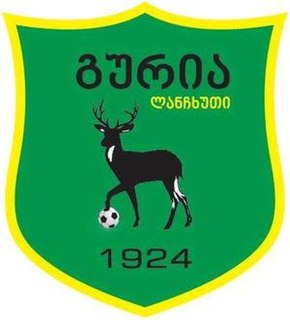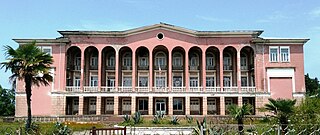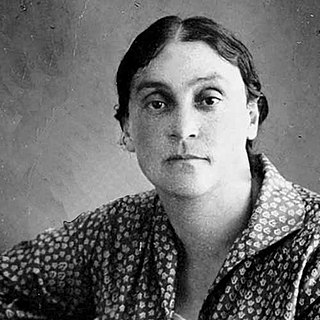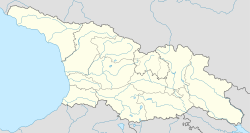
Guria is a region (mkhare) in Georgia, in the western part of the country, bordered by the eastern end of the Black Sea. The region has a population of 113,000 (2016), with Ozurgeti as the regional capital.

The Gurian Republic was an insurgent community that existed between 1902 and 1906 in the western Georgian region of Guria in the Russian Empire. It rose from a revolt over land grazing rights in 1902. Several issues over the previous decades affecting the peasant population including taxation, land ownership and economic factors also factored into the start of the insurrection. The revolt gained further traction through the efforts of Georgian social democrats, despite some reservations within their party over supporting a peasant movement, and grew further during the 1905 Russian Revolution.

Beniamin "Benia" Chkhikvishvili was a Georgian politician who was involved in the Social Democratic movement in the early 20th century. An active member of the Menshevik party, he led the 1905 revolution in Guria, a Georgian province on the Black Sea. He became a de facto head of the peasant government, sometimes described by the contemporary observers as a "Gurian president" or even "Gurian king".

The Principality of Guria was a historical state in Georgia. Centered on modern-day Guria, a southwestern region in Georgia, it was located between the Black Sea and Lesser Caucasus, and was ruled by a succession of twenty-two princes of the House of Gurieli from the 1460s to 1829. The principality emerged during the process of fragmentation of a unified Kingdom of Georgia. Its boundaries fluctuated in the course of permanent conflicts with neighboring Georgian rulers and Ottoman Empire, and the principality enjoyed various degrees of autonomy until being annexed by Imperial Russia in 1829.
The Adjaran dialect is one of the Georgian dialects. It is primarily spoken within the borders of the Autonomous Republic of Adjara, Georgia, in two villages of the adjacent region of Guria and the ethnic Georgian-inhabited areas of Turkey. Adjaran, like Gurian and Imerkhevian, belongs to the Southwestern group of Georgian dialects and is derived from the Meskhet-Klarjetian and surrounding Gurian dialects.

Georgian horsemen were notable participants of the Wild West shows in the 1890s. Billed as Russian Cossacks, the riders from Georgia featured in circuses and shows well into the first half of the 20th century. Their performances, featuring trick riding and folk dance, were extremely popular and exerted significant influence on cowboys in the United States.

FC Guria is a Georgian association football club from Lanchkhuti, which competes in Liga 3, the third tier of the national league.

Ozurgeti is a municipality of Georgia, in the region of Guria. Its main town is Ozurgeti.

The 1841 rebellion in Guria was a conflict in the former Georgian principality of Guria, at that time part of the Georgia-Imeretia Governorate of the Russian Empire, that took place as a reaction to the government's newly introduced duties and taxes for the Georgian peasants. The rebels, joined by several nobles, were initially successful in overrunning much of Guria, but they were finally defeated by the Imperial Russian Army and the allied Georgian nobility in September 1841.

Shekvetili is a village and sea resort in Ozurgeti Municipality, Guria, Georgia, located on the eastern Black Sea coast, at the mouth of the Natanebi river. Shekvetili is home to the popular amusement park Tsitsinatela, large indoor venue Black Sea Arena, and the Miniature Park, an open-air exhibition of scale models of Georgia's architectural landmarks.
Mamia I Gurieli, of the House of Gurieli, was Prince of Guria from 1512 until his death in 1534. Succeeding on the death of his father Giorgi I Gurieli, Mamia became involved in the conflict between the two eastern Georgian kingdoms of Kartli and Kakheti in 1520; by force of arms, he compelled David X of Kartli to agree on peace with Levan of Kakheti, his son-in-law. Mamia Gurieli's 1533 campaign, jointly with his namesake Prince of Mingrelia, against the homebase of Circassian pirates ended in a fiasco, with Mamia being captured and ransomed later that year.
Kaikhosro I Gurieli, of the House of Gurieli, was Prince of Guria from 1626 to 1658. He was installed by Levan II Dadiani, Prince of Mingrelia, in place of his deposed predecessor Simon I Gurieli. In his turn, Kaikhosro was overthrown and expelled by King Alexander III of Imereti. His comeback to Guria, in an Ottoman-supported endeavor, concluded with his assassination by a Gurian nobleman.
David Gurieli was a Georgian nobleman of the House of Gurieli. He was the last titular Prince of Guria from 24 November 1826 to 9 September 1829, but he never actually ruled because of his young age and then due to the Russian occupation of his principality. He reconciled with the Russians and returned from his Ottoman exile as a private citizen in 1832. He was subsequently trained as an officer of the Imperial Russian Army and served in the Caucasus, where he died at the battle of Akhulgo.

The battle of Choloki took place on 4 June 1854 on the outskirts of village Kakuti in Guria during the Crimean war.
Vladimir Aleksandrovich Staroselski was an Imperial Russian official who served as the Governor of the Kutais Governorate from May 1905 to January 1906. A graduate of the Petrovsky Agricultural Academy, he was a known agronomist who had helped stop the spread of phylloxera in Georgia in the 1880s, and was well-known to the Georgian intelligentsia. Appointed governor of Kutais in May 1905 to help with the Republic of Guria peasant revolt, he was asked to help in land reform, one of the key demands of the uprising. He proved too liberal in his dealings, and on the orders of Tsar Nicholas II was removed from his position in January 1906.
Sophia Gurieli, née Tsulukidze (წულუკიძე) was a princess consort of Guria, in southwestern Georgia, as the wife of Mamia V Gurieli. She assumed regency for her underage son David Gurieli in 1826. In 1829 she resisted the Russian encroachment on Gurian self-rule and sided with the Ottoman Empire, but failed and had to flee to Trebizond, where she died the same year.

Elisabed "Liza" Nakashidze-Bolkvadze was a Georgian politician of the Social Democratic Party and member of the Constituent Assembly of Georgia from 1919 to 1921. After the Soviet takeover of Georgia in 1921, she was repeatedly persecuted for being in opposition to the new regime and eventually sent in exile to Siberia, where she was executed in 1937.

Christine Tsintsadze was a Gurian horsewoman from Georgia, who performed trick riding in Wild West shows in the United States. She initially performed with Pawnee Bill and was retained when that show was merged with Buffalo Bill's Wild West Show to create the Wild West and Great Far East show. She was particularly known for her trick riding skills.

Anarchism in Georgia began to emerge during the late 19th-century out of the Georgian national liberation movement and the Russian nihilist movement. It reached its apex during the 1905 Russian Revolution, after a number of anarchists returned from exile to participate in revolutionary activities, such as in the newly-established Gurian Republic.














